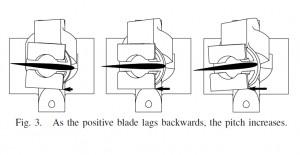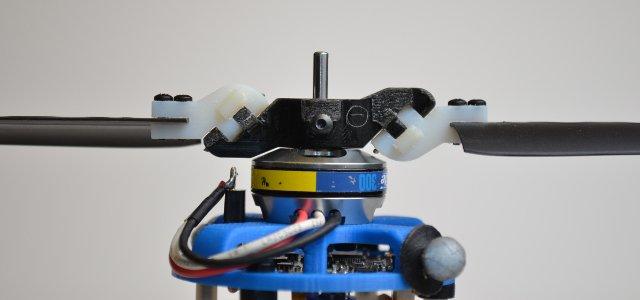The 3D printer may be nothing more than a tool, but it’s a tool which allows for the creation of complex objects that gives researchers, scientists, and artists a way to realize their vision of the future without resorting to painstakingly slow methods of construction.
It’s the speed at which such creators can design, iterate, and build out their ideas which has led to some amazing advances. Take this vehicle made by James Paulos, one of Professor Mark Yim’s students at the University of Pennsylvania Modlab, for example.
A traditional coaxial micro helicopter uses a large propeller motor, and in conjunction with two small servomotors to control thrust, pitch, and roll forces, generates the necessary forces through coordinated control of multiple actuators.
Paulos, seeking to simplify the entire mechanics of such vehicles, 3D printed a novel propeller architecture, one that allows a single motor and rotor to do the same thing a quadcopter can do, but by controlling and modulating the torque applied to one passively hinged, underactuated propeller.
 In flight tests, the two-motor coaxial helicopter demonstrated that this occam’s razor version of a UAV can provide active stability and control in a real flight system.
In flight tests, the two-motor coaxial helicopter demonstrated that this occam’s razor version of a UAV can provide active stability and control in a real flight system.
The three part propeller hub was manufactured on an Objet 3D printer from a plastic polymer, and the fixed hub interfaces with the motor shaft using a commercial aluminum mandrel and two custom plastic blade clamps which connect to the central hub along steel wire hinges.
Conventional UAVs present some serious design challenges and normally require a “swashplate” which means an increase in mass, size, and cost. With four actuators – two big rotor motors, two swashplate servo motors, and a complex linkage assembly – the normal setup is a complicated system indeed.
Paulos says this new rotor system provides “significant system simplifications” while it manages to retain all the advantages of “cyclic control” of current UAV setups.
In Paulos’ system, the main motor directly drives a propeller hub which is itself connected to propeller blades by two inclined, 3D printed hinges. The hinge geometry creates what the designer calls “lead-and-lag oscillations to a change in blade pitch,” and instead of simply driving the motor with a steady torque, a sinusoidal component in phase with the rotation of the rotor can induce a “cyclic pitch variation” which determines the magnitude and direction of the vehicle.
“We can attain this motion directly from a passive dynamic response of the propeller itself,” Paulos says. “For such a propeller the mean applied torque sets the rotational speed and thrust, and an applied oscillatory torque induces the desired cyclic oscillation in blade pitch. Conceptually, this ‘positive’ rotor responds to an impulsive torque on the hub by flexing backwards and exposing increased blade pitch.”
What it means is that the design allows for new types of conventionally-capable micro air vehicles which require just two motors for practical control. Contrast that setup with conventional designs which require many servos and linkages, and the advantages become clear in their simplicity.
Do you think this new rotor and blade design for a UAV represents a workable step forward? Have you worked on UAVs which use 3D printed parts to make them function? Please weigh in with your knowledge or comments in the 3D Printed UAV forum thread on 3DPB.com.
Subscribe to Our Email Newsletter
Stay up-to-date on all the latest news from the 3D printing industry and receive information and offers from third party vendors.
You May Also Like
Kings 3D Introduces Five New 3D Printers Ahead of TCT Asia
In the weeks leading up to TCT Asia, the 3D printing scene in China is already bustling with activity and product promotion. Among the companies taking part is stereolithography (SLA)...
3D Printing Webinar and Event Roundup: April 28, 2024
In this week’s 3D Printing Webinar and Event Roundup, the Ceramics Expo is taking place in Michigan, Stratasys continues its advanced training courses, and SPE is holding a Polymer Characterization...
3D Printing Webinar and Event Roundup: April 21, 2024
It’s another busy week of webinars and events, starting with Hannover Messe in Germany and continuing with Metalcasting Congress, Chinaplas, TechBlick’s Innovation Festival, and more. Stratasys continues its advanced training...
Latest Earnings Overview for Australian 3D Printing Firms Titomic and AML3D
Australian 3D printing manufacturing firms Titomic (ASX: TTT) and AML3D (ASX: AL3) reported their financial results for the period from July to December 2023, marking the first half of their...
































